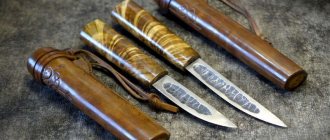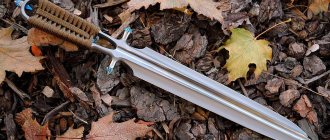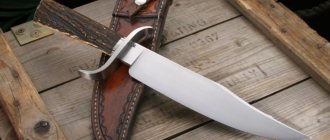The knife throwing technique can be sports, non-revolving, free style. For beginners, the first option is best because it is considered simple and easy to do. The distance to the target for a beginner is 3 meters, it gradually increases and reaches 4-5 meters. It is important to learn how to stand and position your body/limbs correctly when throwing, for example, throwing a knife “from behind the head” can be the initial stage of learning.
You can throw knives both at home and outdoors, but with strict adherence to safety rules. Moreover, not only for the beginner himself, but also for the people around him.
Correct technique for throwing knives
You can learn the art of throwing knives even at home, but there is one regular mistake that all beginners make - the lack of a training system and correct technique when trying to throw a knife accurately at a target. Professionals distinguish three techniques:
- sports - the weapon is grasped at the end of the handle;
- free - the girth is done by the handle or guard (individual convenience);
- non-reversible - the knife is held by the blade/blade.
You need to throw a knife so that it sticks from a distance of 3 meters - this is the initial distance to the target for those who have just begun to master the technique of throwing weapons. Gradually you will need to increase the distance to 4-5 meters.
We recommend reading about whether you can carry a knife with you. From the article you will learn about which knives require a permit, which knife and at what age you can carry it, and prohibited knives. And here is more information about the types of knives and their characteristics.
Best throwing knife
Any knife, even a folding one, is suitable for developing the technique, but you should pay attention to the best throwing ones that meet the following requirements:
- Made from a solid piece of metal. This knife is durable, strong and has excellent weight distribution.
- The mass of a throwing knife should not exceed 200 g. It is inconvenient to throw a super-heavy weapon or a deliberately light weapon, and it will not be possible to master the correct technique of the art.
- The handle is not decorated with any overlays. They can be damaged during training, worsen the weight distribution of the knife, and unbalance the blade.
- The balance is located in the center of the knife. Only in this case can we talk about the balance of the weapon.
Types of throwing knives
1 of 6
Experts believe that you need to immediately purchase 2-3 throwing knives of the same size, weight, and shape - this will make the task of constantly lifting the weapon from the floor easier. Beginners definitely don’t need to experiment and throw knives with different weights/shapes each time. It is difficult to get used to such variety; the correct throwing technique will never be mastered.
How to choose a knife: features of blades
When choosing a knife, you need to pay attention not only to its characteristics, but also to how comfortable it is in your hand. The throwing weapon is taken in the palm of your hand - it should lie comfortably, no effort is required to hold it. It is better if the balancing is done in such a way that the center of gravity is strictly in the middle of the knife.
Features of throwing blades include the absence of sharpening of the cutting edge. The tip of the blade is sharp, but even the existing slopes remain blunt - this is done for safety reasons. Such a knife will definitely stick into the target, but it will not be able to pierce a person’s clothing and skin, so even accidental injuries are excluded.
Watch this video on how to choose a throwing knife:
Throwing a knife from above
How to properly throw throwing knives from above? To complete this procedure you will need:
- Stand with your left side facing the target, with your feet shoulder-width apart.
- Take the knife in your right hand and point your left hand towards the target.
- Swing with your right hand, the knife should be located above the head or at its level.
- The blade should be on the same axis with the forearm.
- Push off with your right foot and throw the blade at the target with a strong swing of your arm. The action is performed while exhaling.
Basic methods of throwing knives
The main methods of throwing knives include:
- non-revolving - the weapon can rotate when thrown, but no more than 90 degrees;
- wave throwing (SCANF) - stands for complex-coordination author's direction of Fedin;
- free style - throwing is carried out depending on the comfort of the grip, developed almost individually;
- sports equipment is the simplest option;
- with a straight hand from above - the grip is made by the handle.
You can start learning with any technique, but first you need to work it until it becomes automatic and you get constant ideal results, and only after that move on to another method.
No revs
Throwing a knife without rotation is quite difficult, so beginners should pay attention to other methods. But if the choice falls on this technique, then you need to know the following nuances:
- the target is installed at a distance of only 1 m 50 cm;
- the thickness of the blade of a throwing knife should not exceed 4 mm;
- blade length maximum 20 cm;
- There should be no lining or decoration on the handle of the weapon to prevent snagging.
Throwing techniques: overhand - throw without rotation;
from below - throw with a half-turn A non-turn throw involves making one turn of the knife with the hand, then it should fly at the target without rotating. In order for everything to work out, you need to learn the correct position of the “throwing” hand. The conditional point will be the elbow, around which the forearm and hand rotate. This point always remains motionless and is located in front of the chest.
The hand performs a rotational movement, which automatically makes the throw stronger/more powerful, and the weapon's flight speed is greater.
Wave throwing (SCANF)
The author of the invention of the wave knife throwing method is Yuri Fedin, therefore the second name of the technique is SCANF. The most important thing is to use the waves of movement of various parts of the body when throwing a knife. Features of the technology:
- during a throw, the body must rotate around its axis;
- at the moment of turning, the hand should “lag” a little behind the body;
- the knife is thrown at the moment of tension in the muscles and tendons of the hand;
- the brush works like a catapult, accelerating the flight of the weapon.
Wave throwing can be used when performing the throwing technique without revolutions and with revolutions.
Watch this video about how wave knife throwing is performed:
Straight hand from above
If the grip is performed with a straight hand from above, then this style is considered free. It is considered simple for a beginner, the execution algorithm is as follows:
- Take the knife in your hand from the butt side. Fingers should not touch the cutting edge, even if it is absolutely dull. The tip of the blade should protrude just a few centimeters from the grasped palm.
- During the swing, the hand remains motionless, only the shoulder “works”. The knife should fly out of your hand at an angle of 45 degrees.
Beginners should start training from a distance of 3 meters from the target; it is better to grip the blade in the first lessons and gradually move it to the handle. As soon as the distance to the target is 4 m 50 cm, you can grab the weapon with a straight hand from above by the handle.
Sports equipment
It is one of the simplest ones; practicing the throw begins at a target at a distance of 3-4 meters. Algorithm for performing the exercise:
- Take a stance - the left leg goes slightly forward, its toe is placed at 3 meters from the target, and the right leg is located behind (this rule “works” only for right-handed people).
- The knife is grasped by the guard or handle, the depth is maximum 4 cm.
- The swing of the “throwing” arm is performed from the shoulder, the limb moves strictly parallel to the body, the knife is thrown at the moment it is located 15-20 cm above the target. The weapon is released smoothly with the palm of your hand, the handle does not compress.
If you throw correctly, the knife will definitely hit the target. This technique results in the knife penetrating the target not strictly parallel to the floor, but at an angle of 60-70 degrees. This happens due to the weapon twisting in the air, so for a more accurate throw you need to grab the knife by the handle to a depth of a maximum of 3 cm.
Two principles for controlling knife rotation in flight
There are two fundamentally different ways to control the rotation of the knife.
The first is considered traditional
It is based on a throwing movement brought to automatism. This can be achieved by repeated repetition of a standard, typical action - a powerful accuracy roll. This is how a penalty kick is practiced in handball or a penalty kick in football.
Preparation, swing, throw... Day after day. Same. Many thousands of times.
Okay, but in a real battle the enemy may be closer or further away. How can one hit it at a distance of two to ten meters using a single, standard throwing movement? To do this, the place where the knife is gripped is shifted, and the knife is given the required rotation speed in each specific throw.
At the same time, the farther the enemy is, the closer to the middle the knife is taken and the slower it rotates in flight. And the lower the speed of rotation of the knife, the greater the distance it will fly, making one revolution (Fig. 68, 69).
This is the throwing technique that is most often used. However, due to obvious limitations, such throwing is usually used against an unsuspecting enemy, for example, from an ambush.
The second method of controlling knife rotation is used much less frequently.
It’s paradoxical, but true: despite the fact that this method is much more difficult to understand and master, it significantly simplifies the use of a combat knife for throwing and expands its capabilities.
The fact is that the concept of “throwing technique” for this method is absent. He does not need painstaking practice of standard throwing movements. Moreover, any rigid, traditional form of throwing is simply harmful for such throwing. Indeed, in this case, the speed of rotation of the knife depends on the form of the throwing movement.
There is no need to stop, take special “throwing stances” and select a grip. The knife is held with the same grip, and each movement of the fighter only enhances the damaging capabilities of the throw (Fig. 70, 71).
In general, it is difficult to imagine a picture of close combat into which throwing of the second type would not “fit” or from which would not naturally “follow.”
This method of controlling the flight of a knife is based on an internal image, a kind of “mental action”. It is not difficult for us to stick the knife in while holding it with our hand. And if, when throwing a knife, imagine that the hand does not release the knife, but reaches the target. It’s not like it’s a throw anymore, it’s more like a blow. But this is precisely the main problem of such throwing.
You must not imitate this blow, do not try to copy it exactly, but actually guide the knife along the trajectory, literally “driving” it into the target. Only in this case will the knife acquire that unique destructive rotation speed and hit the enemy with impeccable accuracy. It is important that even a moment before the knife “came off” the hand, the fighter had already completed the “mental action” - he drove the knife into the target up to the hilt. The actual flight of the knife will no longer be able to influence this result.
How to choose throwing knives for beginners
The choice of throwing knives for a beginner should be made taking into account the following recommendations from experts:
- Check balancing. You need to place the knife on your finger parallel to the floor and try to hold it in this position. It is better if the center of gravity of the weapon is in the middle.
- Study the technical characteristics of the metal. Its hardness should be in the range of 54-56 HRC, and the steel with high wear resistance is class 420.
- Make sure there is no sharpening. This is a safety precaution, because even a small injury can discourage a beginner from throwing.
- Check the length of the blade and all weapons. It is advisable not to use a blade longer than 100 mm, but the total length of the knife should not exceed 205 mm - professionals say that these parameters are ideal for beginners.
An ideal throwing knife for beginners
You should not buy expensive throwing knives, since during numerous training sessions they can get lost, become unusable, and lose their appearance.
How to learn to throw knives at home
You can learn how to throw knives yourself at home using the following algorithm:
- Find the center of gravity of the selected weapon and make sure it is located in the middle.
- Grasp the found point with your thumb and index finger (pinch it), the remaining fingers press the blade to the palm. The blade itself should be located along the life line on the hand.
- Stand 3 meters away from the target.
- Place your left leg slightly forward, move your right hand with the weapon up and back, but the wrist should remain motionless.
- Rotate your body as if throwing a snowball. The grip should not be loosened, because in this case the weapon will begin to rotate randomly and will not hit the target. You cannot lower your hand while throwing.
You shouldn’t squeeze a throwing knife tightly in your palm, but it shouldn’t “dangle” either. Experts recommend standing at a distance of 3 meters from the target, then the knife should be kept closer to the tip of the blade. As the distance increases to 4 meters, the hand moves closer to the end of the handle.
How to choose the right knife
Items for throwing knives are best purchased in specialized stores. The main models that professionals distinguish are:
- "Flying fish"
- "Ascard".
- "Sturgeon".
- "Kharaluga".
Quite often, novice throwers ask the question: how to throw kitchen knives? The fact is that it is undesirable to use them for training, as they bend and break. The best option for mastering throwing skills is a blade with a blade 10–30 cm long and 2–3 cm wide. Affordable knives of good quality are sold on the markets of Bulgaria and Turkey. Products at the resorts of Spain and Italy are much more expensive. When purchasing any knife, do not forget to request a certificate so that during transportation or on the way to the training site there are no problems with law enforcement agencies.
The art of knife throwing
The art of throwing knives is quite “young”, because in ancient times completely different objects were used for throwing:
- sticks - over time they transformed into boomerangs, axes and tomahawks;
- throwing spears - in modern conditions these are darts, pilums and sulitsa;
- stones “turned” into disks, a hammer and cannonballs.
The reason for the long-term neglect of the knife as a throwing weapon lies in the difficulty of stabilizing it in flight. In addition, the tool was lightweight and, even with a powerful throw, did not penetrate the body of an enemy or hunting animal to the required (deadly) depth. Only at the end of the 19th century did knives begin to be used as throwing weapons by both criminals and military personnel. But they never became popular until World War II.
Watch this video about the types of knife throwing and training in examples:
What qualities are needed for throwing?
To learn how to throw knives, you must have the following qualities:
- patience – nothing will definitely work out the first time, only regular training for 1-3 months will give the first results;
- determination - you need to persistently strive for positive results and methodically practice your throws, without being distracted by other entertainment.
Adam Cheladin is a champion in knife throwing.
In addition, you need to have an elastic ligamentous-muscular system, quick reaction, good coordination, a sense of distance and a clear eye.
Equipment
The most important thing in equipment is the choice of knife; experts distinguish 4 types of such weapons:
- flying fish;
- sturgeon;
- Kharaluga;
- askard.
Throwing knife Sturgeon
It is not advisable to use ordinary kitchen knives or folding/penknife knives for throwing, as they do not have the correct weight distribution, they often break and bend. All this significantly worsens the throwing technique and prevents you from achieving success when hitting the target.
The optimal choice of knife for a beginner would be a weapon with a blade width of 3 cm and a maximum length of the entire product of 30 cm. It is worth giving preference to products from Turkish and Bulgarian craftsmen. Italian and Japanese ones are very expensive; they are best purchased for professional use. Additionally, you will need the following equipment:
- tape measure - to measure the distance from the throwing point to the target;
- A stand with sectors will help you accurately control your accuracy.
Knife throwing stand
What difficulties might you encounter?
When learning to throw, beginners may encounter the following problems:
- already in flight, the weapon begins to rotate and change its flight path - you need to check the accuracy of the throwing technique algorithm, train literally step by step (put your elbow at the right point, move your hand back to the right distance, and so on);
- burrs have appeared on the handle of the weapon - they must be cut down, because you can get hurt, drive a metal splinter into your palm or fingers;
- loss of a knife when throwing in nature - it is better to wrap the handle with bright electrical tape so that the search does not drag on;
- pain in the hand after training - you just need to warm up before throwing, warm up the muscles and ligaments.
Five ways to learn to throw a knife
Are you looking for an activity that will simultaneously strengthen your coordination, improve your eye and mood, and, on occasion, help sober up an overbearing insolent person? Don’t torment your punching bag , don’t drown your psychos in a bottle , but try to learn how to throw a knife. Believe me, this particular male hobby will ideally relieve stress (especially if the photo of the culprit is hanging on a shield instead of a target) and teach you to find a calm approach to any problem. Five simple steps will help you master this art: 1. Kill zone You can learn to throw a knife anywhere, even in an apartment. To do this, you need a wooden shield (about 1 sq. m in area) and the absence of easily perishable furniture, household appliances and other material goods nearby. It is also desirable that younger sisters, various kinds of grandmothers calling for food, cats, dogs and stray hamsters do not run into the affected area. 2. Knife from the resort No kitchen or pocket knives - they break and bend easily. And their handles crumble, and the sharpening of the blade quickly becomes unusable. It is best to get special knives for throwing. Sometimes they come across in gun stores, but more often they have to be ordered from knight clubs or from private owners. Another option is to buy throwing weapons at the resort. In Turkey or Bulgaria, for a decent set of five knives they will ask $30. In Spain or Italy, prices are higher – up to 100 euros. 3. How to give a knife a test drive A throwing knife is a narrow blade 10 to 20 cm long, half of which is a metal unfinished handle. The blade, as a rule, has a double-sided sharpening, and the end of the blade has an acute angle. The most important thing in a knife is balancing. Therefore, before shelling out your hard-earned money for it, it would be a good idea to check it out. The center of gravity should be exactly in the middle - both in length and width. Place the knife on your outstretched finger with the middle part of the strip separating the handle and blade. If it lies flat and does not deviate, start bargaining - the product is of high quality. 4. Accurate throw So, take the knife by the blade - when throwing it should slide along your hand. Then make a swing so that the hand at the extreme dead center is approximately at ear level. Then the throw itself - the hand goes softly, but quickly. In no case do you need to put in a lot of effort. The arm stops, fully extended. It is important that at the moment of stopping it is aimed exactly at the intended target. Remember that a hand deviated from the target by a centimeter will miss by at least 15-20 centimeters. The throw involves the shoulder and forearm, but not the hand, which practically does not move. The biggest mistake beginners make is unconsciously using the brush. This will make the throw unpredictable. 5. Tips from the pros Remember that the maximum distance for throwing knives is 5-6 m (about 3-4 turns of the knife).
And one more thing: constantly change the distance. As soon as you learn to hit consistently, for example, from two meters, step back half a step and practice further. From the very beginning, pay more attention to the correctness of the throw - that is, try to make sure that the knife pierces the shield every time. When you can do this without difficulty, start training your accuracy. self defense how to hobby knife
Recommendations from experts
Experts give the following recommendations to beginners in knife throwing:
- An accurate throw can only be accomplished if balance is maintained at the moment the blade is released.
- A throwing knife must be of high quality, with precise weight distribution - there is no need to skimp.
- When aiming, the thumbnail is used as a mark.
- When leaving the palm, the knife should slide along the thumb.
- There is no need to lower your hand immediately after throwing and relax it.
You should also take care of the weapon, and if it is not used for a long time, the blade is wiped with a rag and lubricated with oil.
Recommendations from knife throwing experts
- During the throw, maintain balance, smoothly transferring a little more than half of your weight to your supporting leg;
- Always aim using your thumbnail, similar to the front sight on an air rifle;
- The hand should not fall below the level of the target;
- Avoid whipping your hand - this prevents you from hitting the target;
- Properly store and care for throwing knives - the recommendations are the same as for caring for conventional tools: store the products in a clean, dry place, avoid contact with water and promptly clean the blades from dirt.
You can practice knife throwing on your own, for example, by studying videos on the Internet or under the guidance of an experienced instructor. For those who have never practiced at all, the second option will be preferable.
Myths and reality
Can a throwing knife hit any target at a distance of 20 meters?
This myth arose thanks to films and books, because in them heroes throw weapons without looking and immediately hit the enemy. In fact, the maximum hitting distance is 9 meters.
Does it make a difference what to throw and from what distance?
It's very big! A knife weighing 150g or less is difficult to throw accurately at the target even for experienced people, so beginners may not even start with this. Plastic handles on weapons, windings, and balancers such as metal pommel are also excluded.
Throwing equipment
Do mercury knives exist?
The myth about mercury knives that stick into the target even for beginners is an old “fairy tale” that is replicated not only by amateurs, but even by professionals. No one has ever provided real evidence of the existence of such weapons.
Is it possible to throw only clearly balanced knives with a center of gravity in the middle?
There is actually little difference in terms of balancing. If the center of gravity is shifted to the handle, then the grip should be made straight on the blade, and when balancing closer to the blade, on the handle.
We recommend reading about the best hunting knives. From the article you will learn about the characteristics of a hunting knife, sizes for hunting, selection rules for fishing, hunting and tourism, ranking among the best knives in the world. And here is more information about the best throwing knives for beginners and professionals.
There are several knife throwing techniques, each of them has individual characteristics, but is suitable for beginners. It is enough to purchase equipment and set a goal to learn how to accurately throw a weapon - and the results will appear after just a few training sessions.
NON-REVOLUTIONAL KNIFE THROWING
NAIL AHMADU SYSTEM
1. Requirements for a throwing knife.
I bought my first throwing knife from a Chinese manufacturer for the equivalent of 7 dollars at a kiosk near the metro and on the way home I decided to try it out in a corner of a nearby park. The first time I tried to stick it into the tree, the knife flew straight back at me. On the third attempt, throwing less intensely, I stuck the knife in from one and a half meters away. It entered the maple 2 centimeters. When I tried to press it in by hand, I could only get it a few millimeters into the wood. What is the reason for the high lethality of the knife?
1.1 Arrow effect.
It is impossible to hammer a nail with a hammer.
The hammer hammers with length. In more detail, using the example of an arrow that hits the target.
The destructive effect of an arrow, in addition to its obvious speed and weight, is determined by its length and ideal cylindrical shape. When the arrow hits the target, it releases energy to the target (just like a flat hammer). But from a blow to its shaft, a compression wave begins to spread (the direction is shown by a large arrow), which, reflected from the end of the shaft, moves back to the tip (the direction is shown by a small arrow). Having reached the tip, the wave releases energy to the target, thus ensuring a longer transfer of energy to the target. Over a longer period of time, an arrow, spear, or throwing knife penetrates deeper into the target.
1.2 In what shape of the knife is its damaging effect stronger?
First, the “unsuccessful” forms.
A knife with holes in the handle, like a sheur wrapped around it and cut sausage on occasion. The compression wave is reflected from the holes and the knife “works” with its part (shown in blue). By the way, a cord or electrical tape wound around the handle of a knife should, in theory, “dampen” vibrations in the knife and apparently worsen its quality.
There is a similar situation with a knife that has intricate protrusions from which a wave of indignation is reflected. The knife does not stick into the target with full effectiveness.
The knife has a good shape without unnecessary details and has a straight side, which is essential for the non-revolving throwing technique.
Everything said here applies to relatively light knives (length 20 cm, thickness 3-4 mm). The trend of using the circus (reverse) knife throwing technique leads to the fact that they are trying to use heavier and longer knives (25-30 cm, thickness 6-8 m). Due to the weight, such a cleaver will get stuck in any case - you don’t have to pay much attention to the shape.
2. Non-revolving throwing technique.
A simple analysis of the situation with sports knife throwing in the CIS countries shows that on the one hand, 95% of athletes use the circus (reverse) throwing technique and on 5% there is a remake of non-revolving throwing in which the knife is clamped perpendicular to the palm with the fingers and thrown. The latter method is not described in detail anywhere. A situation arises when everyone understands that “non-revolution” is, of course, better, but very few people have it and therefore, what can you do, you have to rush with the speed. I watched the demonstration performances of reverse throwing masters and could not get rid of the feeling that even their main question is whether they will fit in or not. First, the master throws the knife and it doesn’t stick in or sticks in at an angle. The athlete takes half a step or a third of a step back and forth and, trying to throw in the same way, throws the second knife, which, as a rule, already hits the target well since the distance is corrected. They try to throw without extra effort to control the rotation. Hence the trend towards heavy and long cutlasses. From the point of view of improving the crime situation, it is clear that you can’t really use reverse throwing on the street; now it’s somehow not accepted to walk around belted with swords and daggers. Yes, and asking an angry dog that you want to stick a knife into to stand near that bush over there which is exactly 3 meters away for a couple of seconds is useless... For countries where 20 years ago they were imprisoned for owning jiu-jitsu, this is an argument. On the other hand, a knife is an ancient weapon with centuries-old techniques for its use, and in the end, the truth will still emerge.
Based on some signs, we can say that Ahmadu (Nail) acquired his skills somewhere in Asia, where everything is apparently simpler. Here are his videos with a detailed explanation of his technique. I would like to thank him in absentia for this master class. You definitely won’t get this from our Fedinokims for free.
download as video file *.avi, screen 854x480, size 100MB
https://narod.ru/disk/21331816001/1_2_3.avi.html
or with more standard screen sizes 640x360 size 150MB
https://narod.ru/disk/21361689001/video123.avi.html
So, what can I personally add about the Ahmadou technique? The degree of mastery of the non-revolving throwing technique is expressed by the number of meters from which you stick the knife in without thinking. This is the difference between this technique and “turnover”. An ideal blade master, throwing a knife with zero rotation speed, will stick the knife from any distance - the knife flies without rotating. I throw with a slight rotation, which increases the worse my technique is. At some distance this is unnoticeable, but from a certain distance the blade does not stick. Since there is no coach at hand, Akhmad has to refer to the same videos to catch mistakes. After a week of training, I could barely stick a knife in from two meters, and a week later I tried to kill ants crawling along a tree trunk with a knife from the same two meters. Those. When you learn to confidently stick a knife from a certain distance, you retreat; if it doesn’t work, you watch the video trying to find your mistake. Some typical problems:
2.1. THE KNIFE DOESN'T THROW IT FLIES OUT BY ITSELF
Actually the idea is obvious. Try to throw a stone at a target - you will miss or maybe you will hit. When throwing a knife, the task is twice as difficult; you also need to control the speed and direction of rotation or non-rotation of the knife. A person is not able to do this; he is not a RoboCop. With the non-revolving throwing technique, I control the position of my hands and the knife flies out of my hand under the influence of centrifugal force. Everything is clear in the pictures. At the top, the ring flies off the stick, with the stick serving as a guide. When throwing a knife, the role of a stick is played by the palm and index finger (the finger increases the length of the guide). In the final phase of the throw, the finger points in the direction where the knife is flying (dotted lines in the figure). When you throw, you feel the knife sliding along the finger.
2.2. Problem with fixation (control) of the right elbow when throwing.
The idea here is transparent - the elbow is a conventional point around which the hand with the knife rotates so that centrifugal force acts on the knife. During the final phase of the throw, the elbow should remain in place. The video shows Ahmadou constantly controlling his height with his left hand. In addition to the height, you need to control its position in front of the chest - it should not move to the right. Imagine that in the final phase of the throw you press your right shoulder close to the wall trying to throw the knife along it. If your elbow goes to the right, it will hit the wall. Where does elbow problem come from? Each of us has given up something since childhood and knows perfectly well how to do it. It's at the muscle memory level. The non-revolving throwing technique is based on a different principle and subconsciously it seems that it is wrong. For example, it seemed to me that starting from about three meters I wouldn’t even be able to use a knife using this method. You subconsciously try to strengthen the throw - the elbow goes up and to the right - the knife does not stick in.
2.3 Brush movement.
Shown in the picture. The point of the movement is to make the knife fly out at the right moment due to the additional centrifugal force caused by the rotation of the hand. The lines show the directions of the knife hand and arm. In the video, Ahmadu focuses on this movement; it is very fast - at the moment of the throw, the hand is pulled back and then forward (as in the picture)
master video
source
throwing knives on survive.rf








